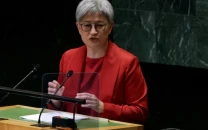Global warming likely to stay at historic levels
UN says 70% chance that 2025-2029 average warming will top 1.5C

The United Nations warned on Wednesday there is a 70 percent chance that average warming from 2025 to 2029 will exceed the 1.5 degrees Celsius international benchmark.
The planet is therefore expected to remain at historic levels of warming after the two hottest years ever recorded in 2023 and 2024, according to an annual climate report published by the World Meteorological Organization, the UN's weather and climate agency.
"We have just experienced the 10 warmest years on record," said the WMO's deputy secretary-general Ko Barrett.
"Unfortunately, this WMO report provides no sign of respite over the coming years, and this means that there will be a growing negative impact on our economies, our daily lives, our ecosystems and our planet."
The 2015 Paris climate accords aimed to limit global warming to well below 2C above pre-industrial levels — and to 1.5C if possible.
The targets are calculated relative to the 1850-1900 average, before humanity began industrially burning coal, oil, and gas, which emits carbon dioxide (CO2) — the greenhouse gas largely responsible for climate change.
The more optimistic 1.5C target is one that growing numbers of climate scientists now consider impossible to achieve, as CO2 emissions are still increasing.
The WMO's latest projections are compiled by Britain's Met Office national weather service, based on forecasts from multiple global centres.
The agency forecasts that the global mean near-surface temperature for each year between 2025 and 2029 will be between 1.2C and 1.9C above the pre-industrial average.
It says there is a 70 percent chance that average warming across the 2025-2029 period will exceed 1.5C.
"This is entirely consistent with our proximity to passing 1.5C on a long-term basis in the late 2020s or early 2030s," said Peter Thorne, director of the Irish Climate Analysis and Research Units group at the University of Maynooth.
"I would expect in two to three years this probability to be 100 percent" in the five-year outlook, he added.
The WMO says there is an 80 percent chance that at least one year between 2025 and 2029 will be warmer than the warmest year on record (2024).
To smooth out natural climate variations, several methods assess long-term warming, the WMO's climate services director Christopher Hewitt told a press conference.
One approach combines observations from the past 10 years with projections for the next decade.
This predicts that the 20-year average warming for 2015-2034 will be 1.44C.
There is no consensus yet on how best to assess long-term warming.



















COMMENTS
Comments are moderated and generally will be posted if they are on-topic and not abusive.
For more information, please see our Comments FAQ